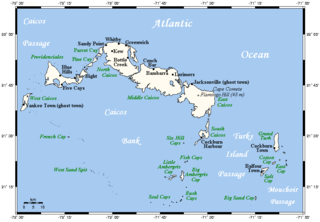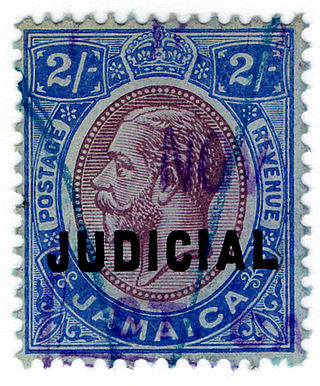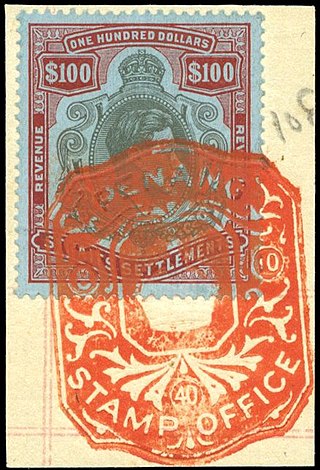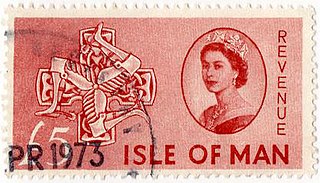
The British colony of Bermuda issued revenue stamps from 1936 to 1984.

The British colony of Bermuda issued revenue stamps from 1936 to 1984.
Until 1936, dual purpose postage and revenue stamps were used for fiscal purposes. In fact the 2s to £1 values from the definitive sets of 1918–1932, while also valid for postal use, were mainly intended for fiscal purposes only. In 1936, a King George V keytype inscribed REVENUE - REVENUE was issued with the face value of 12s 6d. This was used for the collection of passport and visa fees. In the reign of George VI postage stamps were once more used as revenues but a new issue portraying Queen Elizabeth II and the coat of arms of Bermuda was issued in 1954. This was reprinted in decimal currency in 1970, and a new series with a hogpenny coin design was issued in 1984 with values from $1 to $100. [1]
A set of seven values from $1.30 to $10 was issued in 1980 for Contributory Pensions Insurance. The $1.30 and $5 were surcharged in around 1984 with the new values of $1.10 and $8 respectively. [1]

Revenue stamps of Malta were first issued in 1899, when the islands were a British colony. From that year to 1912, all revenue issues were postage stamps overprinted accordingly, that was either done locally or by De La Rue in London. Postage stamps also became valid for fiscal use in 1913, so no new revenues were issued until 1926–1930, when a series of key type stamps depicting King George V were issued. These exist unappropriated for use as general-duty revenues, or with additional inscriptions indicating a specific use; Applications, Contracts, Registers or Stocks & Shares. The only other revenues after this series were £1 stamps depicting George VI and Elizabeth II. Postage stamps remained valid for fiscal use until at least the 1980s.

The island of Antigua issued revenue stamps from 1870 to 1876. The island's short life as a revenue stamp-issuing country was mainly due to the use of postage stamps for most fiscal purposes from 1862 to 1870, and again from 1890 onwards. Therefore, the only revenues issued are more commonly found mint than used. The first set was issued in 1870 and it consisted of eleven values from 1d to 10s, and four of these values were reprinted in 1876 with a different watermark. This makes a total of just fifteen revenues, with most sought after one being the 10s stamp of 1870.

The British colony of Gibraltar issued revenue stamps from 1884 to 1976.

The island of Cyprus first issued revenue stamps in 1878 and continues to do so to this day. The Turkish Republic of Northern Cyprus also issues its own revenue stamps.

The Turks and Caicos Islands issued revenue stamps from 1988 to 1998. The Turks and Caicos Islands normally used postage stamps for fiscal purposes, however on 15 December 1988 they issued a $10 value intended for the payment of departure tax. This did not have any wording on it indicating fiscal use and thus was also accepted for postal purposes. Some years later, around 1992, the same design was reissued but inscribed "DEPARTURE TAX" above the country name. In 1998, a new stamp with the face value of $15 was issued commemorating the cable and wireless centenary.

Bechuanaland first issued revenue stamps as Stellaland in 1884. Note: this information is wrong. Bechuanaland was split into British Bechuanaland and the Bechuanaland Protectorate. British Bechuanaland was added to the Cape Colony and the Bechuanaland Protectorate was governed from Mafeking until the seat of government was moved to Gaberone.

Nyasaland, now known as Malawi, first issued revenue stamps as British Central Africa in 1891 and continued to do so until the late 1980s.
Sarawak issued stamps that functioned as both postage and revenue purposes from 1869 to 1949 from the period of Raj of Sarawak, Japanese occupation, British Military Administration, to Crown Colony of Sarawak.

Revenue stamps of Jamaica were first issued in 1855. There were various types of fiscal stamps for different taxes.

Hong Kong issued revenue stamps from 1867 to the 1990s, both when it was a British colony as well as when it was under Japanese occupation.

Malaysia first issued revenue stamps as the Straits Settlements in 1863, and continues to do so to this day. Over the years, a number of entities in modern Malaysia have issued revenue stamps.

Over the years various Malay States issued their own revenue stamps. Now most states use Malaysian revenue stamps, except for Singapore which is independent and no longer uses revenue stamps.

Revenue stamps of the Isle of Man refer to the adhesive revenue or fiscal stamps which were issued by the British Crown dependency of the Isle of Man between 1889 and 1976. British key type revenue stamps with an appropriate inscription were issued on the island until 1966, when revenue stamps showing various scenes and symbols of the island began to be issued. The last set of stamps was issued in 1976. From around 1920 to the 1970s, hundreds of contribution stamps were issued for National Insurance and related schemes.

Uganda issued revenue stamps from around 1896 to the 1990s. There were numerous types of revenue stamps for a variety of taxes and fees.
Revenue stamps of Fiji were first issued in 1871 or 1872, when the Fiji islands were an independent kingdom. The first revenue stamps consisted of postage stamps overprinted with the letter D.
Revenue stamps of Seychelles were first issued in 1893, when the islands were a dependency of the British Crown Colony of Mauritius. The first stamps were Mauritius Internal Revenue stamps depicting Queen Victoria overprinted for use in Seychelles, and Bill stamps were also similarly overprinted. Postage stamps depicting Victoria or Edward VII were overprinted for fiscal use at various points between 1894 and 1904, while surcharges on Bill stamps were made in around 1897–98.
Few revenue stamps of Nigeria and its predecessor states have been issued, since most of the time dual-purpose postage and revenue stamps were used for fiscal purposes. The first revenue-only stamps were consular stamps of the Niger Coast Protectorate and the Southern Nigeria Protectorate, which were created by overprinting postage stamps in 1898 and 1902 respectively. The Northern Nigeria Protectorate did not issue any specific revenue stamps, but a £25 stamp of 1904 could not be used for postal purposes due to its extremely high face value.
Revenue stamps of the Gold Coast were issued by the British Colony of the Gold Coast between 1899 and the early 20th century. Dual-purpose postage and revenue stamps were used for most fiscal transactions, so few revenue stamps were issued.

Revenue stamps of the Leeward Islands were issued by the British Leeward Islands between 1882 and the 1930s. They were used on Antigua, the British Virgin Islands, Dominica, Montserrat and Saint Kitts and Nevis, all of which also issued their own revenue stamps before, during or after they used common issues for the Leeward Islands.

A postage and revenue stamp, sometimes also called a dual-purpose stamp or a compound stamp, is a stamp which is equally valid for use for postage or revenue purposes. They often but not always bore an inscription such as "Postage and Revenue". Dual-purpose stamps were common in the United Kingdom and the British Empire during the 19th and 20th centuries, and they are still used in some countries as of the early 21st century.